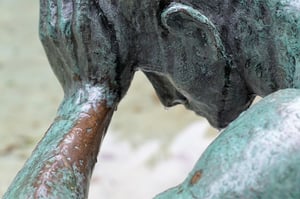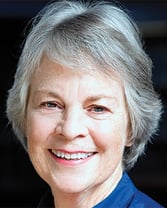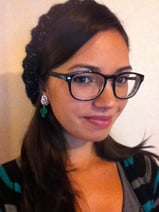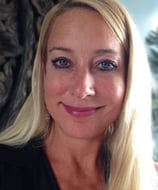A blog post by Melissa Ruisz Nazario, based on an Interview with Ann Belford Ulanov, Ph.D., L.H.D., by Bonnie Bright, Ph.D.
Listen to the full audio interview with Ann Ulanov here. (approx. 31 minutes)

In the book The Unshuttered Heart: Opening Aliveness/Deadness in the Self, Jungian analyst Ann Belford Ulanov, Ph.D., L.H.D., says, “we can find our depth by being found in the depths.” But what does it mean, "to be found in depths"? For those of us who constantly seek to better understand ourselves and the world around us, or, as Joseph Campbell said, are "seeking an experience of being alive," what are some ways that we might find ourselves in these depths, to gain those profound insights that help us experience being alive? Ann, who is a prolific author and presenter at Pacifica’s upcoming sold-out Trauma and Transcendence conference in June 2018, says that one way we can find our depth in the depths is through our dreams. “You can’t make up the dream,” she says. “The dream makes up you. And some dreams you really get right away, and they tell you something you never knew before, and it’s as if you’re being addressed.”
“Other dreams,” Ann says,“are so opaque, that you may not know what they’re about for years. And then there are lots of dreams, one patient of mine said they’re like dresser drawer dreams, you just dump the dresser drawer in your psyche and out comes this and that, and it doesn’t seem to mean anything, but the depth there is that something is addressed to you."
As an example, Ann notes that one of her patients, who was not formally educated, relied on her dreams a great deal. “And she said, because it’s not your idea, and it’s not even my idea, it’s something in me that talks to me, and I believe I have to listen to it, because it says things I can’t think of by myself,” Ann recalls. “So that’s one example of depth.”
 Another example of finding incredible moments of depth and insight is within a well-developed relationship between analyst and patient, or analysand. “If you’re working overtime in a relationship with the analyst and analysand, things can happen there that you don’t get to by yourself,” she notes. “It isn’t that the analyst gives you the answers, it’s that things occur to you when you’re trying to tell the analyst something, or when you’re arguing together, or when you’re blocked together, things occur that don’t occur outside of the analysis time, and that’s sort of amazing, it’s creative flashes that happen.”
Another example of finding incredible moments of depth and insight is within a well-developed relationship between analyst and patient, or analysand. “If you’re working overtime in a relationship with the analyst and analysand, things can happen there that you don’t get to by yourself,” she notes. “It isn’t that the analyst gives you the answers, it’s that things occur to you when you’re trying to tell the analyst something, or when you’re arguing together, or when you’re blocked together, things occur that don’t occur outside of the analysis time, and that’s sort of amazing, it’s creative flashes that happen.”
However, finding oneself in the depths isn’t always positive, Ann points out. “There are lots of negative depths, of terror, sheer terror, that you can’t stand to think about,” Ann says. “Nightmares will do it, and you’re so glad about electricity, that somebody invented electricity because you can turn your light on and know that you’re not hanging by your heels hanging over a cliff. You’re in your bed and there are your bedroom slippers on the floor.”
Analysis can help a patient uncover those negative depths, and provide space to understand and cope with them, Ann observes. “The negative also takes you down, and if you’re in a good solid working [analyst-analysand] relationship, you become able to bear more and more than you would be able to do by yourself,” she says.
“And that’s the depth that may uncover a lifelong sadness that’s haunted you all your life, that now you begin to understand, and you now can afford to see what that sorrow is about. Or it might be a lifelong madness, a chunk that’s crazy, that you could not afford to make room for, and the analysis makes room for. So, your perception of yourself, your perception of reality changes radically, but it’s these kinds of personal, particular, very varied, according to each personality, it’s those kinds of experiences that are the depth, that analysis can engender.”
Ann’s most recent book, The Psychoid, Soul and Psyche: Piercing Space-Time Barriers, explores Carl Gustav Jung’s concept of the psychoid. “Psychoid refers to unconscious processes that are unrepresentable in word or image,” Ann says. “We live them, but we don’t know about them. And they can make us feel mad, not angry, but crazy, and I believe they can also be a third source of healing.” She goes on to describe psychoid as “this unrepresentable level of the unconscious processes. [Jung] would say the archetype, for example, is of a psychoid nature, meaning by that, you don’t experience it directly. You experience it through derivatives. An emotion will grip you; a behavior will possess you or compel you. Images would arise or attract you.”
 There is a connection between experiencing the psychoid and synchronicities, those “meaningful coincidences.” [1] Ann recalls that Jung defined a synchronistic experience as “non-causal elements coincide and bestow on us, or impact us with an experience of deep meaningfulness, and we aren’t clear whether the meaning exists external to us, so it feels it does, but somehow we participate in it.” Furthermore, Ann says, “the psychoid and synchronicity evoke each other, and both, for Jung, have moments of making you feel connected to what he called the unus mundus, the one world, the larger surround, not just in which we live, but in which life is.”
There is a connection between experiencing the psychoid and synchronicities, those “meaningful coincidences.” [1] Ann recalls that Jung defined a synchronistic experience as “non-causal elements coincide and bestow on us, or impact us with an experience of deep meaningfulness, and we aren’t clear whether the meaning exists external to us, so it feels it does, but somehow we participate in it.” Furthermore, Ann says, “the psychoid and synchronicity evoke each other, and both, for Jung, have moments of making you feel connected to what he called the unus mundus, the one world, the larger surround, not just in which we live, but in which life is.”
Ann also notes that Jung described the unus mundus, or one world, as more than psychological. “It has social, international, environmental, chemical, and cosmological properties, this one world,” she remarks. “But the thing that stands out about psychoid process, and archetypes too, because he does say they are psychoid in nature, is that the experience is manifest physically as well as psychologically, psychically, and they’re not two parallel processes. They’re two sides of the same coin, so that they’re astonishing experiences when they happen.”
Such an extraordinary experience can feel distressing, but also elicit a deep meaningfulness. “So, something’s happened, and in these experiences, synchronistic or the psychoid, the ego way of living, or differentiating of having a time and a space, and all those familiar markers dissolve,” Ann says.
“It’s all time, not just past or present or future. It’s all spaces, not just there, but also here. And in those experiences, everything is present simultaneously. So, the ego can feel completely overwhelmed, and feel mad in the sense of madness, and/or one might feel liberated from the usual structures, in seeing the wholeness of the whole, seeing the all in all, existing in it in the moment, so it’s a major kind of experience.”
This type of experience is also transgressive, Ann observes. “All the usual boundaries get superseded,” she says. “We transgress them. Archetypal constellations go beyond their frame of reference. Psychoid processes upend the way we usually define things, and it depends on where you’re coming from, whether it frightens your wits out of you, or whether it liberates you–it’s like a leap to another way of perceiving the real.”
Ann is interested in the effects of experiencing the unus mundus, or one world, in a clinical setting, especially when it deals with grave matters like the suffering of trauma. “Trauma is terrible; It can be acute, or it can be chronic,” Ann says. “No big event happened, but like a water torture, drip, drip, drip, over years, something was really off, and it started so early that you just thought this was reality. But it dealt a hurt that you feel is beyond repair. That’s the hurt of trauma, that it’s beyond repair, that you’re damaged.”
 When we suffer from trauma, our psyches go to work to help us survive and cope. “There’s a gash, and you’re stuck there, and you’re stuck in there, and you’re wounded, and you’re not sure you’re going to survive it,” Ann says. “So, with the remarkable capacity of psyche to cope and to invent, defenses are erected, and walls are erected, and images are erected, that both terrify and keep us away, and wall off to protect us so we can live in another chunk of our lives, but the wound is there, and the wound is in us.”
When we suffer from trauma, our psyches go to work to help us survive and cope. “There’s a gash, and you’re stuck there, and you’re stuck in there, and you’re wounded, and you’re not sure you’re going to survive it,” Ann says. “So, with the remarkable capacity of psyche to cope and to invent, defenses are erected, and walls are erected, and images are erected, that both terrify and keep us away, and wall off to protect us so we can live in another chunk of our lives, but the wound is there, and the wound is in us.”
While those coping mechanisms may have helped us to survive the trauma, over time they can also cause us to suffer, as they no longer serve us. The psychoid, with its ability to bring forth an experience of unus mundus, or one world, can help release us from those defenses. “So the simultaneity of everything all at once, which feels on the negative side, like chaos, might also on the positive side, feel like plenty, like abundance, that makes us feel unmoored from our usual crippling defenses, that are impossible to relinquish– they just sort of fade away,” Ann says. “The boundaries with which we define things–and in trauma, you’re fixated on very painful, repetitive, compulsive boundaries–they yield.”
Even though it requires a lot of work and a good, solid relationship between the analyst and analysand, the experience of dealing with trauma can be rich and rewarding for both. “You need a sturdy relationship, analytically, with your analysand, and the analysand with you, to survive these experiences, but it adds something to the clinical venture that is really quite wonderful, in my experience,” Ann says.
“You’re still in your role of analyst, or analysand, and you’re still looking at the patient’s material, and the material in trauma is usually desperately full of suffering, but the two people who are in their roles, are also two human beings together, facing the forces of destructiveness and creation, creativity, in life itself, and the analyst gets there in the participation in looking at those forces through her own root, her own experiences of suffering, of destructiveness, or creativeness.”
The wounds of trauma may never fully heal, but working through those experiences can help us to perhaps transcend them, so that they no longer define us, Ann posits. “Transcendence is something that at least evokes something larger, something that changes the proportion so that you look at the wound that you feel is beyond repair from a different point of view, from a larger point of view,” she says.
“That larger perspective, experiencing it, it pulls you loose from your trauma, it works it and reworks you, and how would you come out? How would I describe that? The wound may always be there, because serious things happen to us, and they’re dreadful, and you can’t fall back on ‘good comes out of evil.’ It’s not enough. So, the wound may always be there. The wound may always be bleedable. It’s not all healed up, scabbed over. It may be, and it may be healed, but it may not be. But we no longer live in the wound of trauma. The wound of trauma lives in us. That’s the difference. So that we’re not defined as a trauma. We can suffer it, we’ll go on suffering it, but it has its place. And its place is limited. It is in us, we are not engulfed in it. Transcendence, whatever meaning we give to it, and I’m wrestling with that for the June conference, gives us that larger perspective, and the experience of the psychoid level does too. So, that gives you an idea of where the healing comes from.”
[1] Tarnas, Richard. (2006). Cosmos and Psyche.New York: Penguin Group. P. 50. ISBN 0-670-03292-1. Accessed from https://en.wikipedia.org/wiki/Synchronicity#cite_note-1

Ann Belford Ulanov, Ph.D., L.H.D., is a Jungian analyst in private practice in New York City, a member of the Jungian Analytic Association, and former Christiane Brooks Johnson Professor of Psychiatry and Religion at Union Theological Seminary. An internationally known lecturer and prolific author, among her many articles and books are the highly acclaimed Cinderella and Her Sisters: The Envied and the Envying; Spiritual Aspects of Clinical Work; The Wisdom of the Psyche; The Unshuttered Heart: Opening to Aliveness/ Deadness in the Self; The Living God and Our Living Psyche; and Madness and Creativity.

Melissa Ruisz Nazario is a graphic designer and social media consultant for Pacifica Graduate Institute. She is also the production manager and webmaster for Immanence Journal and creative director for Total Okinawa magazine. In 2006, Melissa earned an M.A. in English and American literature at the University of Texas at El Paso (UTEP). Her thesis, “Parting the Shadowy Veil: Trauma, Testimony, and Shadow in Toni Morrison’s Beloved” received UTEP’s 2006 Honors Convocation Award for Outstanding English Thesis. Melissa has served as a content editor and graphic designer for the U.S. Marine Corps Public Affairs Department in Okinawa, Japan, as well as a technical writer and quality assurance specialist for Advanced Computer Learning Company in North Carolina. As an educator, she has taught college-level literature, composition, and drama; she also taught English as a second language to adults and children in Japan.
 Bonnie Bright, Ph.D., earned her doctorate in Depth Psychology at Pacifica Graduate Institute. She is the founder of Depth Psychology Alliance, a free online community for everyone interested in depth psychologies, and of DepthList.com, a free-to-search database of Jungian and depth psychology-oriented practitioners. She is also the creator and executive editor of Depth Insights, a semi-annual scholarly journal, and regularly produces audio and video interviews on depth psychological topics. Bright is especially interested in ecopsychology, dream work, and divination, and has completed 2-year certifications in Archetypal Pattern Analysis via the Assisi Institute and in Indigenous African Spiritual Technologies with West African elder Malidoma Somé. She has also trained extensively in Holotropic Breathwork™ and the Enneagram.
Bonnie Bright, Ph.D., earned her doctorate in Depth Psychology at Pacifica Graduate Institute. She is the founder of Depth Psychology Alliance, a free online community for everyone interested in depth psychologies, and of DepthList.com, a free-to-search database of Jungian and depth psychology-oriented practitioners. She is also the creator and executive editor of Depth Insights, a semi-annual scholarly journal, and regularly produces audio and video interviews on depth psychological topics. Bright is especially interested in ecopsychology, dream work, and divination, and has completed 2-year certifications in Archetypal Pattern Analysis via the Assisi Institute and in Indigenous African Spiritual Technologies with West African elder Malidoma Somé. She has also trained extensively in Holotropic Breathwork™ and the Enneagram.



